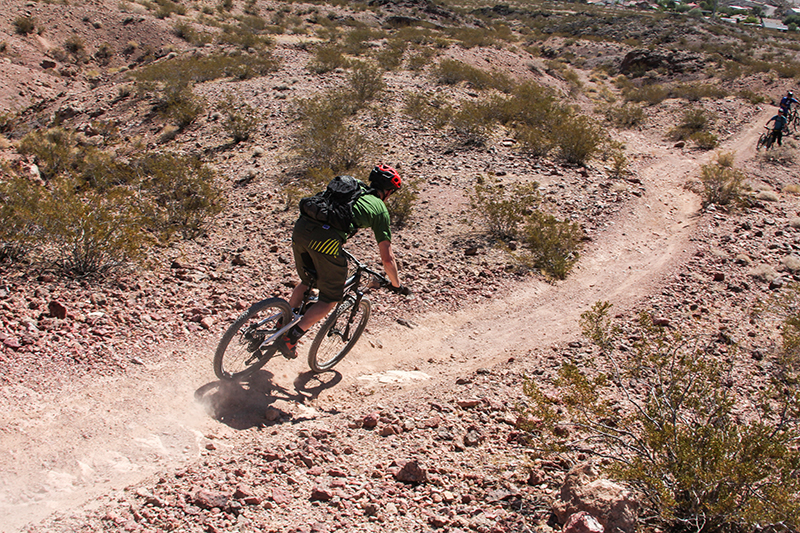The Ride
I hopped on the Django 27.5 immediately after doing a couple laps on the Django 29, and at the risk of stating the obvious, the bikes have a lot of similarities. In fact, the differences are almost exactly what you’d expect when changing wheelsizes; the 27.5 feels more maneuverable, it accelerates a bit quicker, and it generally feels more playful. But the 27.5 also feels less stable, and at higher speeds, particularly through chunky terrain, it’s noticeably twitchier.

In terms of the suspension, both Djangos do an exceptional job of smoothing out the trail – they have great small bump sensitivity, but they don’t feel overly soft or wallowy. The suspension is relatively progressive, so they also handle big hits competently. This is one spot where I did notice a difference between the Django 29 and the Django 27.5 – the 29 had a Fox Float rear shock with an Evol air can while the 27.5 had a Rockshox Monarch RT3 Debonair. Both shocks felt great on small and mid-size hits, but the Fox did a noticeably better job of handling harder hits – the Rockshox was much more inclined to bottom out harshly.
Pedaling efficiency on the Django 27.5 is quite good, and it does a nice job of staying just active enough to help out with traction on bumpy climbs without being so mushy that the suspension feels like it’s sucking all your energy.
The Django isn’t the lightest bike in this class, and it loses out a little bit on climbs to some of its more svelte competitors, but its pedaling efficiency and climbing friendly geometry mean that it actually goes uphill pretty well. It’s also worth noting that, while the frame isn’t crazy light, it’s stiffer than a lot of other bikes in this class, which helps out on the way down. The frame also comes with a lifetime warranty, which is increasingly rare these days.
Descending on the Django is more about slaloming through corners and popping off of pretty much everything than it is about straightline high speed destruction. The Django isn’t as stable as something like the Transition Scout, but in tighter spots it feels more maneuverable.
Like the Django 29, the Django 27.5 would be a great bike for someone who spends a lot of time on longer backcountry rides. It’s efficient enough that it can tackle big days with lots of climbing without killing you, but it’s supple and forgiving enough that it won’t beat you up like an XC bike would. And, of course, it’s still a blast on the descents.
If you’re looking for some comparisons, you can check out where we ranked the Django in our 27.5” trail bike roundup. If you’re back and forth between the Django 27.5 and Django 29, I think the question should simply come down to your thoughts on 29” wheels. Does the slower handling and acceleration of the bigger wheels bother you? Then yeah, go with the 27.5. Personally, for a shorter travel bike like this, I like the extra stability and roll-overness that the 29er gives you. I’ve gotten used to giving the bike a little more body english to make it do what I want, so for my money, I’d get the Django 29. But they’re both great bikes, and I know plenty of rational, sane people who prefer the smaller wheels.
Bottom Line
The Django 27.5 is an easy bike to like – it climbs pretty well, but it also has forgiving suspension that does a great job of handling everything from small roots to big compressions. And that’s packaged into a stiff, burly chassis that should hold up to many years of abuse.
That competency both on the way up and on the way down makes the Django 27.5 a strong contender for those that need a bike that can do a bit of everything. It also means that people who are spending time doing huge climbs followed by equally huge descents should pay attention to the Django 27.5 – it’s more climbing focussed than it’s bigger brother, the Troy, but it’s still a competent descender that can be ridden hard.
